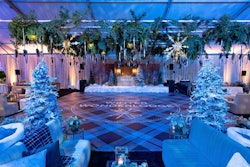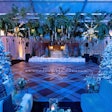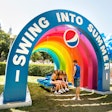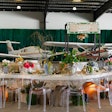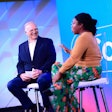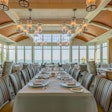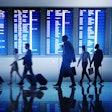
In an effort to bring more manufacturing back to the U.S. and to pressure foreign countries, President Donald Trump recently announced increased tariffs on goods from Mexico, Canada, and China.
So far, he’s imposed 25% tariffs on all steel and aluminum imports, as well as 25% tariffs on other imports from Mexico and Canada along with a 20% levy on Chinese goods. He’s also expected to announce reciprocal tariffs on April 2.
For example, Trump is threatening to impose 200% tariffs on EU wine imports, in response to French politicians’ proposed tariff on U.S. whiskey.
Economists warn that the higher tariffs will result in higher prices for consumers, and they may also reduce the range of products available by making some importation unprofitable.
For the event industry, this translates to increased costs for things like booth builds, signage, lighting, and even venue operations.
The policies may also impact corporate travel, with companies sending fewer international representatives to trade shows and conferences (perhaps because the U.S. is viewed as inhospitable), and more and more exhibitors may decide not to participate in events because of the absorbent costs.
The possible upside? Rising costs may inspire renewed interest in hybrid and virtual events because they’re more cost effective.
BizBash asked some event profs how the tariffs are affecting (or will affect) their businesses, and for advice on how folks can navigate the impact.
How has your business been affected so far?
“As a scenic fabricator, the tariff increases are hitting metals the hardest with their 25% hit,” explained Austin Johnston, founder and CEO of AKJOHNSTON Group, referring to the increased tariffs placed on all steel and aluminum imports earlier this month. He estimates that the increase means an average “customer hit” of 7% to 10% for metal items like aluminum wall framings and structural metals.Johnston said that his company’s plan is to absorb some of the increased costs for their clients, “which will affect our bottom line, but it remains a muddy picture fueled by fear and uncertainty.”
Shana Carr, COO of experiential marketing agency Impact XM, expressed similar issues, saying that the tariffs will impact all aspects of the business.
"The imposed and retaliatory tariffs are driving up costs in key areas such as raw materials, electronics, technology, and logistics, all of which are essential to our business. Increased costs for aluminum, steel, and other fabrication materials will directly affect custom exhibits and structural builds. Supply chain disruptions may cause delays and increase freight costs, impacting the timely delivery of exhibits and event assets."
How are you handling client relationships?
Carly Katz-Hackman, chief sales officer of Pinch Food Design, said the catering company isn’t panicking for the sake of its clients. “We don’t want to join the fray of alarm-ringing for our clients. Our costs have been up and down this year—at whiplash speed—so right now we’re doing our best to keep an eye on things, identifying what’s a trend or blip versus what will have staying power.”“Our clients have not been surprised by price increases as long as they make sense,” she added. “I think some companies can choose to take advantage in times like these, but I find that if you continue to price yourself with integrity, and not just the market, then people will understand the value in what they’re receiving when choosing you as a vendor.”
DKC Analytics recently released a report, “A Business Leader’s Guide to Talking Tariffs,” to help inform businesses on how to address consumer backlash around tariffs. Of 10 potential tariff response messages tested in the survey, buyer confidence improved when companies stressed complete transparency about the impact of tariffs on the business, the need to support employees, and the temporary nature of price increases.
"We’re having ongoing conversations with our clients about the budget implications for their event programs," Carr said. "Most understand the cost pressures and our need to adjust pricing accordingly. We are partnering with them to strategically plan ahead to lock in pricing as well as explore alternative solutions such as rentals, material substitutions, and modular designs to offset further cost escalations."
Do you think event budgets will increase in response to the tariffs?
The short answer, it seems, is no. Budgets will most likely stay the same or even decrease, according to the event profs. Instead, clients and event planners will need to strongly define priorities and goals.“Unfortunately, I don’t think most organizations will be willing, or even able, to increase event budgets to offset rising costs driven by tariffs and ongoing inflation,” said Nicola Kastner, CEO of Event Leaders Exchange (ELX).
Johnston knows this firsthand, saying his “clients have pretty consistently said for at least the first half of 2025 that their budgets and activity will remain retracted: less budget and less volume. ... My hope is that people do not undercut out of desperation so that our clients can understand that budgets do need to increase for our industry to be sustainable.”
“Event planners will need to proactively engage stakeholders in open conversations about these implications and discuss the difficult trade-offs that will inevitably arise,” Kastner said. “Having a clear understanding of event priorities and intended outcomes will help frame these conversations and determine what elements can realistically be scaled back or removed.”
Katz-Hackman echoed that sentiment, saying, “For our clients, I always advise to prioritize, and that’s more important now than ever before. What’s important to you? What’s important to the success of your event? What’s important to your guest experience? Choose your buckets and allocate the budget accordingly.”
What can event profs do to lessen the potential impact?
Overall, planners will need to rethink sourcing strategies and explore local and domestic suppliers to mitigate potential pricing shifts, as well as consider adjusting event timelines."We are leveraging our multiple fabrication facilities in the U.S. and Canada to optimize production and reduce transportation costs. By strategically determining which location to produce and ship from based on the event destination, we help clients minimize transportation costs, avoid import/export fees, and shorten lead times to maximize their budgets," Carr explained.
She added that event profs should consider optimizing transportation and logistics by consolidating shipments, plan ahead to reduce expedited freight costs, and leverage fabrication and production locations to minimize transportation expenses.
Katz-Hackman, who acknowledged “those egg prices are no joke!,” said that Pinch sources locally, which should help keep costs stable. “But again, we’re keeping an eye on things and not getting ahead of ourselves. The import costs for wine are certainly concerning, but for our menus, we do our best to shop local always, so we’re optimistic that the foreign tariffs won’t hold too much power.”
“My strongest advice to event professionals is to be proactive rather than reactive. Start scenario planning now. Evaluate which aspects of your events may be impacted by tariffs, potential restrictions, or shifting attendee patterns, and then identify possible alternatives,” said Kastner, who received a staggering number of responses when she recently posted about the topic on LinkedIn.
“This could mean exploring local suppliers, however, the reality is supply chains are so interdependent, even local options could be impacted by tariffs," she added. "I personally think it is wise to partner with finance teams ASAP to start to build contingency scenarios into your budgets, so you’re prepared if costs rise unexpectedly or planned revenues decline due to reduced attendance from international or public sector attendees.”
She also advised that event professionals proactively incorporate hybrid and virtual event formats into their strategic planning now rather than waiting to react. “Embracing these formats as a strategic part of an event portfolio proactively will ensure events remain resilient, engaging, and impactful, no matter what challenges emerge.”
While Johnston admits that the tariffs on Canadian lumber in 2018 had a positive impact overall, he said that the most recent ones are definitely concerning. “The immediacy of this [policy] is clearly a political statement and does not allow for business and industries to plan or anticipate really anything at all. Whether you agree with the administration’s tariffs or not, I think we can all agree that the speed and justification for this one is rooted more emotionally than economically, which will leave business owners holding the bag.”
“What makes this even more challenging is that the goalpost keeps moving," Kastner added. "Uncertainty around policy shifts, timing, and economic impacts will require planners to communicate frequently, remaining flexible, responsive, and highly strategic as conditions evolve.”







